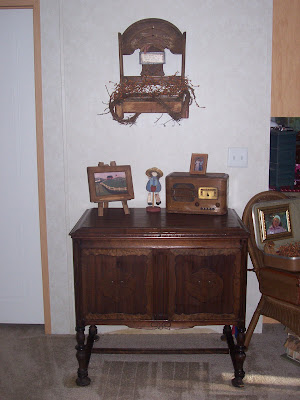This information was taken from
goatworld.com. Please feel free to check out their site for more on Goat Terminology. Many of these terms I have never used nor will you under normal care of your goat. Our boer doe ,Daisy, is showing signs of kidding anyday now, when she does I will be sure to post all about kidding. We will kinda learn together you might say.
Abomasum
The fourth or true digestive part of a ruminant's stomach that contains gastric juices and enzymes that begin the breakdown of complex materials.
Abortifacients
A drug or other agent used to cause abortion. Other agents could be considered as toxins or poisons from plants, trees, etc.
Abortion
Expulsion of the fetus (or fetuses) by a pregnant female before the normal end of a pregnancy.
Acidosis
A condition when the rumen becomes too acid. Usually due to over-consumption of grain.
ADF
Acid Detergent Fiber; an indicator of relative digestibility of forages.
Aflatoxin
Toxin produced by the fungi Aspergillus flavus and Aspergillus parasiticus.
Afterbirth
The fetal membranes that attach the fetus to the membranes of the pregnant female and which are normally expelled from the female within 3 to 6 h. after parturition.
AI (Artificial Insemination)
The technique that involves breeding of females without the males being physically present.
Ante-mortem
Before death.
Anthelmintic
A compound that kills or expels internal parasites - such as worms.
Antibiotic
Chemical compounds from living cells, that inhibit growth or kill microorganisms.
Artificial Rearing
Raising a kid on milk or milk replacer.
Atrophy
Wasting away or decreasing in size of cells, organs or entire body; due to disuse, disease or severe malnutrition.
Banding
This involves the use of castration rings (bands) to remove the testacles.
Billy
Male goat; frequently used to describe an older, adult male goat - non wether.
Body Condition Score
A value from 1-5 (thin to fat) used to estimate condition of an animal.
Bolus
A large oval shaped pill containing antibiotics.
Bots
Tiny larvae that crawl into nasal passages.
Breeding Season
The period of time when the doe is showing estrus.
Brood Doe
A doe kept for the purpose of continuing a desireable bloodline and genetics in her offspring.
Browse
Broad-leafed woody plant, shrub or brush.
Brucellosis
Infection with bacteria of the Brucella group, frequently causing abortions in animals and remittent fever in man. Also called Undulant fever, Malta fever, or Mediterranean fever.
Buck
Male goat.
Buckling
Baby male goat.
Burdizzo
Tool used to castrate bucks by severing the cord without breaking the skin of the scrotum.
Butting
Method of fighting among goats (especially bucks) by the striking of the head and horns.
CAE
Caprine Arthritic Encephalitis, a goat virus alot like AIDS in humans.
Calcium to Phosphorus Ratio
Relative amounts of calcium and phosphorus in the total ration. Usually recommended to be at least 2:1.
Chevon
Goat meat.
CC
Cubic Centimeter, same as ML; 3CC and 3ML are the same thing in shots.
Chlamydia
Small organisms associated with pneumonia, abortion, diarrhea, conjunctivitis, arthritis and encephalitis.
Chlamydiosis
Type of infectious abortion.
CL
Caseous Lymphadenitis, an abscess disease of goats that is highly contagious.
Cloning
The production of genes or individuals which are genetically the same as the donor.
Clostridial Organisms
Anaerobic bacteria that produce spores under certain conditions.
Cocci
An oxycyt that destroys the lining of the small intestine causing diarrhea and death; (also known as coccidiosis)
Coccidiosis
An oxycyt that destroys the lining of the small intestine causing diarrhea and death; (also known as cocci)
Colostrum
The first milk full of antibodies for the kids, essential to their life.
Corpus luteum
A ductless gland developed within the ovary by the reorganization of a Graafian follicle following ovulation. Also known as an extract of this gland of the hog or cow, the chief principle of which is progesterone. plural = corpora lutea.
Corticosteroids
Any of a class of steroids, as aldosterone, hydrocortisone, or cortisone, occuring in nature as a product of the adrenal cortex, or synthesized. Also called corticoid.
Creep
An enclosure into which young (small) animals may enter but larger animals cannot. Any feeders in this area or in farrowing crates or parturition pen that are only accessible to the young are called creep feeders.
Critical Temperature
Maximum or minimum environmental temperature tolerated by the animal before additional dietary energy is required to maintain normal body temperature.
Crossbred
The offspring resulting from mating a buck and doe of different breeds.
Crossbreeding
Mating plan involving two or more breeds.
Cryptosporidiosis
An organism that proliferates in the small intestine.
Culling
The process of removing animals that are below average in production, unsound or undesirable.
Culls
Goats which are below a required standard.
Custom Feeding
The practice of having livestock fed and managed for the livestock owner in another facility for a fee.
Cut
To castrate.
Cysticercosis
The condition where a larval form of a tapeworm has encysted or embedded itself in the tissue of its host.
Dehydrate
The loss of body fluids by fever, virus or heat.
Disbudding
The practice of removing the horns on a goat.
Doe
Female goat.
Doeling
Baby female goat.
Drenching
The oral administration of medication.
Drylot
A penned area for holding the herd for an extended period with or without housing.
Dry Matter
(DM) The portion of feed that is not water.
Elastrator
Instrument used to apply heavy rubber bands (elastrator rings/bands) to tail and scrotum for docking and castration. Some breeders also used this method for disbudding.
Embryo Transfer
Recently fertilized eggs from donor doe are transferred to the uterus of a recipient doe, usually by surgically exposing the uterus of the recipient.
Emaciation
To waste away physically.
Encephalitis
Inflammation of the brain usually with severe signs such as fever, incoordination, and convulsions.
Enteritis
An inflammation of the intestinal tract.
Enterotoxemia
Actually misnamed "overeaters", it is a toxin in all healthy goats, that multiplies with a stressor to cause stomach cramps and death.
Enterotoxemia Type C
Disease that affects goats in the first two weeks of life causing bloody infection of the small intestine and rapid death.
Enterotoxemia Type C and D Toxoid
Vaccination given to young goats to build up antibodies against Enterotoxemia type C and D. It is also available combined with tetanus vaccination.
Enterotoxemia Type D
Disease that affects unvaccinated goats that have been placed on high energy diets.
Entropin
A heritable trait in which the lower eyelid is inverted, causing the eyelashes of the lower lid to brush against the eye.
Esophageal Feeder
Tube placed down the esophagus of a goat to administer milk or other liquid.
Estrogen
Hormone that causes regression of the corpus luteum and stimulates estrus.
Estrous Cycle
The time period from beginning of one heat to the beginning of the next heat. Usually about 16-17 days.
Estrus
The period of time when the female is sexually receptive to the male, Usually 24-36 hours, also known as "heat".
External Parasite
Parasites that may be found on the hair, skin and in the nasal and ear passages.
Fecundity
Efficiency of an individual in production of young. Animals that bring forth young frequently,
regularly, and, in case of those that bear more than one offspring at a birth, in large numbers, are said to be fecund.
Fertility
The ability to produce offspring.
Fetus
The unborn young in the later stages of development.
Flight Zone
Maximum zone of comfort or security of animals.
Flushing
Management practice of improving a does's plan of nutrition just prior to mating to improve ovulation rate.
Foot Bath
Chemical and water mixture, that goats stand in, used for the prevention and/or treatment of foot rot and foot scald.
Forage
Fiber-containing feedstuffs such as silage, hay and pasture.
Forcing Pen
Pen used to confine animals prior to moving them into treatment chutes.
Freshen
To come into milk.
Galatopoiesis
Stimulating milk production.
Gambrel Restrainer
Restraining device that is a gambrel-shaped piece of plastic that is placed over the top of the animal's neck, with slots on either side to hold both front legs of the animal.
Gastroenteritis
An inflammation of the stomach and intestines.
Gestation
Period of pregnancy beginning at conception and ending with birth (142-152 days).
Grafting
Fostering a kid onto a doe that is not its natural mother.
Group Fed
Feeding system where all animals in a group are fed at one time.
Guard Dog
A dog that stays with the goats without harming them and aggressively repels predators.
HACCP
Hazard Analysis Critical Control Point, an internationally recognized and recommended approach to food safety that anticipates and prevents hazards associated with ingredients.
Heat
See estrus.
Helminths
Parasitic worms.
Herd
"Herd" is a term that describes a small (or large) group of goats. Goats are "herd" animals meaning that they will thrive better with one or more of their same kind in numbers. By comparison, almost every species is given a specific group term; "flock" of geese, "pride" of lions, "pack" of dogs, "school" of fish...
Hypocalcemia
Low levels of calcium in the blood.
Hypomagnesemia
Low levels of magnesium in the blood.
Hypothermia
Inability to keep warm often caused by cold or wet weather.
IM
Intramuscularly, in the muscle shot.
Immunity
Developing resistance to a specific pathogenic microorganism.
Intermediate Host
An animal or other living body in which a parasite completes part of its life cycle and usually causes no damage.
Internal Parasites
Parasites located in the stomach, lungs and intestines of goats.
International Unit
(IU) Unit of measurement of vitamins and drugs.
Iodine
Disinfectant used on navels of newborn goats that helps dry up the navel, thus closing the passageway into the body of the goat. Also applied to hooves of newborns by some breeders. Veterinary iodine contains 7% iodine while common iodine for humans contains 2% iodine.
Johnes
A wasting disease of ruminants, contagious in their fecal matter (poop).
Keds
Bloodsucking ticks that pierce the skin causing serious damage to the pelts.
Ketones
Compounds found in the blood of pregnant goats suffering from pregnancy toxemia.
Known Carrier
An animal that has produced offspring with a genetic defect.
Kid(s)
Baby goats, either sex.
Kidding
Having babies.
Lactation
The period of time when the doe is producing milk. Normally from birth of kid to weaning.
Lactated Ringers Solution
Used for adding body fluids to a dehydrated goat (known as LRS).
Legumes
Family of plants bearing seeds in a pod. Alfalfa hay is an example of a legume.
Leucocyte (leukocyte)
Usually referring to white blood cells.
Liver Flukes
Small leaf-shaped organisms that roll up like a scroll in the bile ducts or liver tissue.
Loading Chute
A chute used for loading animals into a truck or trailer.
Lochia
The dark blood discharge a doe has for several weeks after kidding.
LRS
Used for adding body fluids to a dehydrated goat (known as Lactated Ringers Solution).
Lungworms
Roundworms found in the respiratory tract and lung tissue.
Mange Mites
Mites which infest and damage the skin and hair.
Manure
Poop, nanny berries, fecal matter, excrement.
Mastitis
Inflammation of the mammary gland caused by bacterial infection, resulting in reduced milk
production.
Metritis
An inflammation of the uterus.
Milk Fever
Substantial reduction in plasma calcium which interferes with nerve transmission, causing partial or almost total paralysis occurring at or just giving birth and initiation of lactation.
Milk Replacer
Artificial milk substitute fed to young goats.
Mineral
Inorganic substance found naturally in all body cells, tissues and fluids.
Mitigation
To make less harsh or severe; using goats to control brush or weeds is commonly referred to as
mitigation.
ML
Milliliter, same as CC; 3CC and 3ML are the same thing in shots.
Monogastric
An animal with a single compartment stomach. Goats are not monogastric.
Mycotoxin
Toxic compounds, produced by fungi, that contaminate plants.
Nanny
A mother goat; infrequently used depending upon your location.
Natural Immunity
Inherited resistance to disease that varies between breeds, strains within breeds and individuals.
Necropsy
Examination of a dead animal to determine cause of death.
Nematode
Also called Roundworms, nematodes are among the most abundant animals, occurring as parasites in animals and plants or as free-living forms in soil, freshwater, marine environments, and even such unusual places as vinegar and beer malts.
Nitrate Poisoning
Condition in which toxic levels of nitrates accumulate in plants.
Nose Bots
Tiny larvae that crawl into nasal passages.
Omasum
The third part of the ruminant stomach located between the reticulum and the abomasum.
Oocyst
A stage in the life of coccidia (a protozoal parasite) that is shed in manure. Goats become infected by ingesting oocysts from contaminated pastures.
Orifice
The hole in the end of a teat.
Ovary
Primary female reproductive organ.
Over the Counter Drugs
(OTC) Drugs that can be purchased directly by the producer.
Palatability
This refers to how avidly a goat will choose from among several different choices of feed.
Parasite
An organsim that lives off of a host.
Parous
Females that have produced young.
Parturient Paresis
Substantial reduction in plasma calcium which interferes with nerve transmission, causing
partial or almost total paralysis occurring at or just giving birth and initiation of lactation.
Parturition
The act of bringing forth young; childbirth.
Pinkeye
A highly contagious disease that affects the eyes of goats (also contagious to humans).
Placenta
The big membrane that the doe expells after kidding.
Post Mortem
After death.
Postpartum
After birth.
Prepartum
Before birth.
Pregnancy Toxemia
A metabolic disease of pregnant does generally caused by diet deficient in energy during late pregnancy.
Probiotic
Living organisms used to manipulate fermentation in the rumen.
Progeny
Offspring.
Prolificacy (fecundity)
The number of offspring actually produced by a female.
Protein
Nitrogen-based essential nutrient, composed of chains of amino acids, that is present in all living things.
Protein Supplement
Feedstuff that contain a high level of protein. Fed to animals in addition to their base diet.
Ration
A mixture of feedstuffs fed to animals over a 24 hour period.
Rehydrate
The addition of body fluids which have been lost from fever, illness, heat, etc.
Rennet
Extracted from the fourth stomach, the enzyme component rennin is used to coagulate milk.
Reticulo-Rumen
Section of the ruminant gastrointestinal tract consisting of the reticulum and the rumen that is the primary site for microbial fermentation of feedstuffs.
Reticulum
The second compartment of the ruminant stomach, also known as the second stomach. The lining has a honeycombed appearance to increase the surface are for absorption.
Rigor Mortis
The permanent contraction of skeletal muscle associated with death.
Roughage
Coarse, bulky feed high in fiber such as hay, straw and silage.
Rumen
The large first compartment of a ruminant's stomach containing microbial population that is capable of breaking down forages and roughages.
Rumen-Reticulum
Pregastric fermentation chamber that host a large microbial population.
Ruminant
A group of animals that chew their cud and characteristically have a four compartment stomach.
Rumination
The process of regurgitating food to be rechewed.
Scours
Diarrhea usually only associated with incorrect milk feeding.
Shipping Fever
Respiratory disease usually accompanying transport.
Silage
Green forage converted to a succulent feed of 30% - 40% dry matter for goats by storing without air (as in silo or air-tight bags).
Sire
The father.
Soremouth
A highly contagious (also to humans), viral infection that causes scabs around mouth, nostrils, eyes and may effect udders of lactating does.
SubQ
Subcutaneous, under the skin shot (sometimes written as SQ or sq).
Synchronization
A management practice used to cause the goats to cycle at the same time.
Systemic Disease
A disease where more than one portion of the body is affected; often the whole body or one or more systems.
Total Digestible Nutrients
(TDN) Standard system for expressing the energy value of feeds.
Trace Minerals
(TM) Minerals that are required in very small amounts.
Urinary Calculi
Metabolic disease of male lambs characterized by the formation of stones within the urinary tract. It is caused primarily by an imbalance of dietary calcium and phosphorus.
Uterus
Portion of the female reproductive tract where conceptuses devolop prior to birth (womb).
Vaccination
Injection, given to healthy animals, used to stimulate prolonged immunity to specific diseases.
Vaginal Prolapse
Protrusion of the vagina in does in late pregnancy.
Vitamins
Small organic compounds, necessary for proper metabolism, that are found in feed in minute
amounts. Deficiencies result in distinct diseases or syndromes.
Wether
Castrated male.
White Muscle Disease
A disease caused by a deficiency of selenium, Vitamin E or both that causes degeneration of skeletal and cardiac muscles of goats.
Withdrawal Period (or time)
The time when a drug must not be administered prior to marketing to insure that no drug residues remain in the meat or milk.
Yearling
A one year old goat.
Zoonosis
Diseases of animals that can be transmitted to humans.
Zygote
The product of fertilization, ie. a cell formed from the union of an oocyte and a spermatozoan.
 All this came from the coop, mostly old wood chips and sawdust that I put in there in the spring last year. Losts of good nitrogen in that pile of poop.
All this came from the coop, mostly old wood chips and sawdust that I put in there in the spring last year. Losts of good nitrogen in that pile of poop. Cleaned out the chicken run too and add some hay and leaves for them to play in. Would love to let them free range but the cyote's would have all in a night. They are happy and well feed.
Cleaned out the chicken run too and add some hay and leaves for them to play in. Would love to let them free range but the cyote's would have all in a night. They are happy and well feed.






















 Nut with outer shell removed.
Nut with outer shell removed. I then place the nut in a small vise that I picked up somewhere cheap. A larger one would do a little better.
I then place the nut in a small vise that I picked up somewhere cheap. A larger one would do a little better.

































